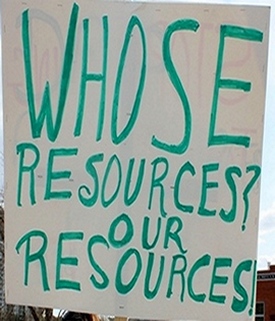|
March 22, 2021 - No. 20
Infrastructure Projects Related to
Minerals Critical to U.S. War Economy
Rio Tinto Announces Scandium Oxide
Pilot Plant in Sorel-Tracy
- Fernand Deschamps -
  
• Rio Tinto's Role in the Scandium and Aluminum Alloy Market
• Pay-the-Rich Scheme: Part of the "Green Economy"
Infrastructure Projects Related to Minerals Critical to U.S. War Economy
- Fernand Deschamps - Rio Tinto has announced that it "will become the first producer of
high-quality scandium oxide in North America" with a new
commercial-scale pilot plant to be built in Sorel-Tracy, Quebec.
 On one of Rio Tinto's websites dedicated entirely to scandium, we
learn that the company has "developed a new process to extract high
purity scandium oxide from the ilmenite ore at our metallurgical
installation in Quebec, Canada."[1]
The mining and metallurgical company has developed a new
process to extract scandium oxide, classified as a critical mineral,
from by-products generated during the production of titanium dioxide at
the Rio Tinto Fer et Titane (RTFT) metallurgical complex in
Sorel-Tracy, Quebec. On one of Rio Tinto's websites dedicated entirely to scandium, we
learn that the company has "developed a new process to extract high
purity scandium oxide from the ilmenite ore at our metallurgical
installation in Quebec, Canada."[1]
The mining and metallurgical company has developed a new
process to extract scandium oxide, classified as a critical mineral,
from by-products generated during the production of titanium dioxide at
the Rio Tinto Fer et Titane (RTFT) metallurgical complex in
Sorel-Tracy, Quebec.
Scandium is used to produce high performance aluminum alloys. It is
a silvery white metallic element that falls into the rare earth
category which, when used in small quantities, has drastic effects on
properties of matter. Addition of only 0.1 to 0.2 per cent of
scandium in aluminum alloys substantially increases mechanical
strength, heat
and corrosion resistance, as well as improves welding properties.
In the late 1950s, the Soviet Union had developed scandium-aluminum
alloys which were used in the construction of military aircraft,
advantageous for fighter jets such as the Mig-21 and Mig-29, as well as
for missiles, in terms of weight, maneuverability and range.[2]
In recent years, the U.S., Canada, Australia and the European Union
have all classified scandium as a critical mineral. In January 2020,
Canada and the U.S. finalized a Canada-U.S. action plan on
critical minerals collaboration to secure supply chains for critical
minerals -- such as scandium -- which are "needed for important
manufacturing
sectors, including communication technology, aerospace and defence, and
clean technology."[3]
 In
February 2020, TML Weekly published an article entitled "Canada-U.S.
Joint Action Plan on Critical Minerals Collaboration -- No to Canada's
Integration into the U.S. Imperialist War Economy!" The article
explains how the federal and Quebec governments had been working hand
in hand since 2019 with the U.S. Trump administration to
ensure the supply chain of 35 strategic and critical minerals for the
U.S. war economy.[4] In
February 2020, TML Weekly published an article entitled "Canada-U.S.
Joint Action Plan on Critical Minerals Collaboration -- No to Canada's
Integration into the U.S. Imperialist War Economy!" The article
explains how the federal and Quebec governments had been working hand
in hand since 2019 with the U.S. Trump administration to
ensure the supply chain of 35 strategic and critical minerals for the
U.S. war economy.[4]
Now further developments will take place with regard to strategic
minerals, as revealed in the Joint Statement issued following the
bilateral virtual meeting held between Prime Minister Justin Trudeau
and U.S. President Joe Biden on February 23, in which "[t]he leaders
agreed to strengthen the Canada-U.S. Critical Minerals Action Plan to
target a net-zero industrial transformation, batteries for
zero-emissions vehicles, and renewable energy storage."[5]
Currently, global demand is estimated at between 12 and 15 metric
tonnes per year, mainly supplied by China and Russia. With the new
applications that are being developed, this demand is set to grow. Some
analysts are predicting that by 2028, the demand could be as much as
300 metric tonnes per year. Rio Tinto's first module pilot plant
expected to begin production by the end of June 2021, will have a
capacity for three metric tonnes per year of scandium oxide. A Rio
Tinto spokesperson noted that the plant can be scaled up by adding more
modules to meet demand. Production could be increased to reach
over 12 metric tonnes annually according to estimates provided.
Rio Tinto's scandium website mentions that the company's operations
in Quebec are "a new innovative, reliable and accessible alternative to
existing and limited sources of scandium in the market. [The]
advantageous geographic location in northern Quebec, Canada, is ideal
for efficiently supplying the North American market."[6]
Notes
1. Element North 21, Rio Tinto
2. Project Scandium Aluminium Europe (SCALE) supported by the European Commission.
3. "Canada
and U.S. Finalize Joint Action Plan on Critical Minerals
Collaboration," News Release, Natural Resources Canada, January 9, 2020
4. "Canada-U.S.
Joint Action Plan on Critical Minerals Collaboration - No to Canada's
Integration into the U.S. Imperialist War Economy! - Fernand
Deschamps", TMLWeekly #2, February 1, 2020
5. "Summit
Between Canadian Prime Minister and U.S. President -Joint Statement of
President Biden and Prime Minister Trudeau at the Conclusion of Their
Meeting, TML Monthly, March 7, 2021.
6. Element North 21, Rio Tinto.

Scandium is a rare earth element. It is used in the
manufacturing of military and civilian aircraft, lasers and fuel cells.
Scandium oxide comes in the form of a white powder, the price of which
varies according to purity and supply and demand. There is no organized
global market for scandium at this time. According to the U.S.
Geological Survey, in 2019 high purity scandium oxide sold for around
$3,900 U.S. per kilogram.
Scandium oxide is also used to produce high performance
aluminum-scandium master alloys for the aerospace and military
industries, and for 3D printing. Its advantage is to produce alloys
which make it possible to carry out highly efficient welds, that would
reduce the weight of aircraft by 10 to 15 per cent and reduce the time
required for
their assembly.
 The
most important application of these alloys remains in the production of
combat aircraft as evidenced by the title of a promotional item
recently published on the Rio Tinto website entitled "Mineral Waste to
Fighter Jets -- Pioneering a new source of a critical mineral." In that
article Rio Tinto touts the fact that scandium is a by-product of
tailings recycling once the ilmenite ore concentrate is processed to
recover titanium oxide. According to the reasoning promoted by various
levels of government, the recovery of scandium to make alloys with
aluminum fits nicely into the "sustainable development" projects of a
"green economy," as promoted by the federal and Quebec governments, all
this to divert from the fact that "scandium can be used in industries
like aerospace and defence."[1] The
most important application of these alloys remains in the production of
combat aircraft as evidenced by the title of a promotional item
recently published on the Rio Tinto website entitled "Mineral Waste to
Fighter Jets -- Pioneering a new source of a critical mineral." In that
article Rio Tinto touts the fact that scandium is a by-product of
tailings recycling once the ilmenite ore concentrate is processed to
recover titanium oxide. According to the reasoning promoted by various
levels of government, the recovery of scandium to make alloys with
aluminum fits nicely into the "sustainable development" projects of a
"green economy," as promoted by the federal and Quebec governments, all
this to divert from the fact that "scandium can be used in industries
like aerospace and defence."[1]
A Rio Tinto January 14 press release also states that scandium oxide
is used to improve the performance of solid oxide fuel cells, which are
used as a power source for data centres and hospitals, as well as in
niche products such as lasers for military purposes, the lighting of
stadiums or television studios.
Other future applications are computer and television screens, more
conductive high voltage transmission cables and in the automotive
industry where aluminium-scandium alloys 40 to 60 per cent lighter and
with a higher hardness coefficient are expected to increasingly replace
steel, titanium and other composite materials used in hybrid and
electric vehicles.[2]
Today, for example, aluminum-scandium-magnesium alloy powder is used
for additive manufacturing (3D printing of metals by laser fusion) to
create components used in aircraft construction. This enables the
creation of high strength components for the aerospace industry which
include exceptional high fatigue resistance properties with a high
strength coefficient close to that of titanium alloys but less dense.
Scandium is also found in electronic ceramics and glass compositions.
Some of the ceramics created with scandium have a very high hardness
that approaches that of diamonds.
Notes
1. "Mineral Waste to Fighter Jets -Pioneering a new source of a critical mineral," Rio Tinto website.
2. "Are Aluminium-Scandium Alloys the Future?," Aluminium Insider, July 28, 2017

In its January 14 press release, Rio Tinto announced that it "is investing U.S.$6 million for the construction of a first
module in the plant, with an initial capacity to produce three tonnes
of scandium oxide per year, or approximately 20 per cent of the current
global market." The government of Quebec will contribute to the project
to the tune of approximately $850,000 within the framework of the
$68-million pay-the-rich scheme announced last October by the Legault
government as the "Québec Plan for the Development of Critical
and Strategic Minerals 2020-2025 for a greener Quebec."[1]
In its October 24, 2020 issue, The Marxist-Leninist Weekly had
already highlighted how the federal and Quebec governments responded to
the Trump administration's call to secure a supply chain for minerals
critical to the U.S. war economy.[2]
By integrating, among other things, the Canadian rail
network with the North American rail network, the economies of Canada
and Quebec are being prepared to participate in the increasingly fierce
inter-monopoly and inter-imperialist rivalry for the control of sources
of raw material, commodities, markets and spheres of interest.
This is how Quebec's Minister of Energy and Natural Resources,
Jonatan Julien, qualified the Rio Tinto announcement: "RTFT's scandium
oxide valorization project is a concrete example of how we can extract
value from our mining wastes. It demonstrates our ability to innovate
and seize business opportunities in a growing market as we
strive to ensure secure supplies of critical minerals. This business
has the potential to become a major scandium supplier outside China."[3]
Rio Tinto Fer et Titane (RTFT) already operates an open-pit ilmenite
mine in Quebec at Lac Tio, near Havre-Saint-Pierre, on the North Shore,
which is the largest ilmenite deposit in the world (see location "A" on
the Quebec map). The ore is then sent by ship to its metallurgical
complex in Sorel-Tracy, where titanium dioxide, pig iron, steel
and world-class metal powders are extracted (see location "B" on the
Quebec map). In total, nearly 1,650 workers are employed at these two
Quebec sites.
Rio Tinto is currently testing the production of small quantities of
a high-performance aluminum-scandium master alloy using scandium oxide
produced by RTFT, with the support of its aluminum sector based in the
Saguenay-Lac-St-Jean region in Quebec (see location "C" on the Quebec
map).

Map showing the three major Rio Tinto sites for mining (A) and refining
(B) titanium and refining aluminium (C) in Quebec (click to enlarge)Quebec's
Saguenay-Lac-Saint-Jean region is also an important hub for the
aluminum sector, which for Rio Tinto represents almost half of its
global production of this metal. Rio Tinto's activities in the region
include an alumina refinery, four wholly owned aluminum smelters, six
hydroelectric plants, the Arvida Research and Development
Centre (CRDA), the Aluminium Operational Centre, a rail network and a
port.
All these infrastructure projects related to minerals critical to
the U.S. imperialist war economy are considered part of a "sustainable
greener economy." Their aim, however, is not a sustainable natural
environment but to serve the U.S. war economy and its striving for
world hegemony over China and Russia. War production is the greatest
cause
worldwide of collective insecurity as well as pollution. So long as
the aim is to make the rich richer, extracting scandium from
by-products generated during the production of titanium dioxide will
not be used to serve the people. Canada's highly qualified work force
and its resources are its greatest assets which must be brought under
the
people's direction and control.
Notes
1. "The
Gouvernement du Québec launches the Québec Plan for the
Development of Critical and Strategic Minerals: future resources for a
greener Québec," Quebec Government Press release, October 29,
2020
2. "Canada's
Strategic Critical Minerals:Who Decides? -- Integration of Quebec's
Northern Regions into U.S. War Economy - Fernand Deschamps," TMLWeekly
#40, October 24, 2020
3. "Rio Tinto enters scandium market with construction of new plant in Canada," Rio Tinto January 14, 2021 press
release.

(To access articles individually click on the black headline.)
PDF
PREVIOUS
ISSUES | HOME
Website: www.cpcml.ca
Email: office@cpcml.ca
|

